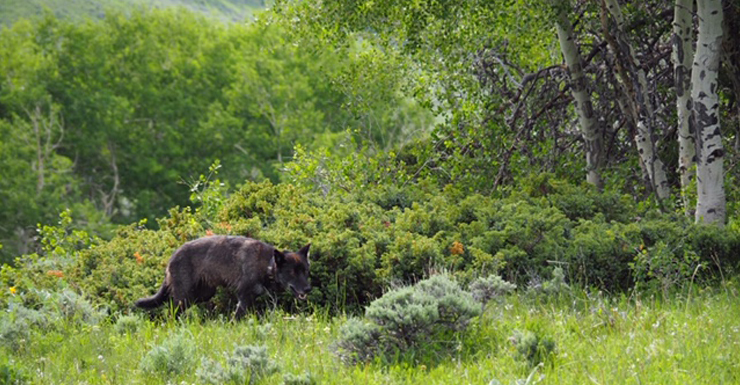
Gray Wolf
The gray wolf (Canis lupus) ranges across Eurasia and in North America, from the Arctic to Mexico and from coast to coast. Once distributed statewide, the gray wolf had long been extirpated from the state, with wolves deemed off the landscape by about 1940. Colorado has seen lone wolves travel in and out of the state over the past few decades with a lone wolf, F1084, taking up residence in the state in July 2019. This animal was collared as part of Wyoming Game and Fish monitoring efforts. In 2020, a pack of wolves was identified in the Northwest part of the state. In 2021, a second lone wolf joined F1084; collared by CPW and identified as 2101. In June 2021, CPW biologists visually confirmed six pups with F1084 and 2101, marking the first known breeding pair in the state in several decades.
Sometimes called "timber wolves" (to distinguish it from the coyote, or "prairie wolf"), wolves occupy a wide range of habitats. Wolves once fed on Colorado's vast herds of bison, elk and deer, supplemented by rabbits, rodents and carrion.
When market hunters overhunted the large mammals that constituted wolves' staple diet, wolves naturally turned to a new food resource in the developing frontier: livestock. Because of their depredations of domestic animals/livestock, wolves in Colorado were systematically eradicated by shooting, trapping and poisoning.
With reintroduced populations becoming sustainable across the United States, including Wyoming, Montana and Idaho, many wildlife professionals believed it was only a matter of time before the wolf naturally migrated back to Colorado.
The gray wolf in Colorado is protected by the federal Endangered Species Act (ESA) and state law. Unlawful take penalties can vary and can include fines up to $100,000, jail time and loss of hunting privileges.
Colorado wolves now have a 10(j) designation in effect under the Endangered Species Act that lists them as a nonessential, experimental population (NEP). While designated as a NEP, wolves remain both federally and state protected as an endangered species. Designation as a NEP allows increased management flexibility under very strict circumstances regarding conflict with livestock. Killing of wolves outside of these circumstances remains illegal.
Between December 18 - 22, 2023, CPW experts released 10 gray wolves onto public land in Grand and Summit counties in a historic effort to create a permanent, self-sustaining wolf population and fulfill a voter approved initiative to re-establish gray wolves in Colorado.
The gray wolves were captured in Oregon, where CPW veterinarians and biologists evaluated them to determine if they were fit for relocation to Colorado. Criteria for release included the age, sex, health and body condition of each animal.
As outlined in the Colorado Wolf Restoration and Management Plan, CPW hopes to release a total of 30 to 50 wolves over the next 3 - 5 years using wolves captured from nearby northern Rockies states (from several different packs by trapping and darting them in the winter).
Appearance
Wolves are large canids, up to five feet long (14 inches of which is a bushy tail). Their coloring is pale gray, washed with buff and overlain on the back and legs with black. Sometimes their pelage (fur) is black.
Habitat and Young
Wolves den in burrows in banks where the female bears six to 10 pups in late April after a nine-week gestation period. The male provides food for the nursing mother. A pair may have a hunting territory of 10 square miles.
Proposals have been made to restore wolves to wilderness ecosystems of Colorado, where they could provide a natural check on elk populations, for example. The suggestions have met with considerable opposition from some ranchers.
What is an Extirpated Species?
An extirpated species is an animal that no longer exists in the wild in its historical habitat but still exists elsewhere. Wolves used to be an example of a species extirpated in Colorado; however, as recently as 2019 a pack has started living in the northwest corner of the state. Between December 18 - 22, 2023, Colorado Parks and Wildlife wildlife experts released 10 gray wolves onto public land in Summit and Grand counties.
Mexican Wolf (Canis lupus baileyi)
The Mexican wolf is a distinct subspecies of wolf. It is listed as Endangered under the Endangered Species Act. Therefore, it is under the management authority of the U.S. Fish and Wildlife Service.
The historic range of the Mexican wolf includes New Mexico, Arizona, and Mexico. Wolves are capable of traveling long distances, and although solitary Mexican wolves may occasionally have explored the state, there is no evidence that populations of the subspecies ever resided in Colorado.
The recovery area for mexican wolves is limited to portions of AZ, NM and Mexico. The USFWS has recently changed the boundaries for the Mexican wolf experimental population area, extending it from Highway 40 (an east-west highway between Albuquerque and Flagstaff) south to the Mexican border.
Press releases and FAQs on the USFWS's recent actions regarding Mexican wolves are available at the provided links.

